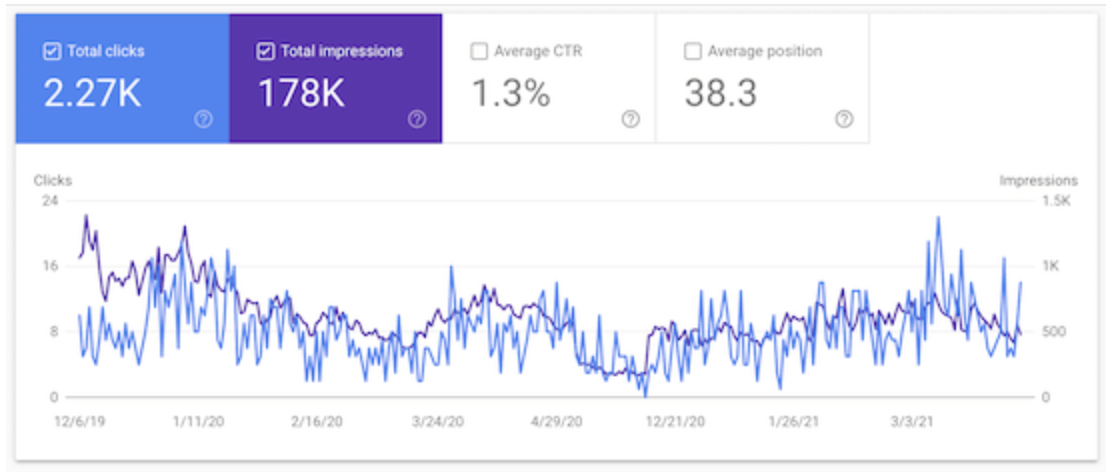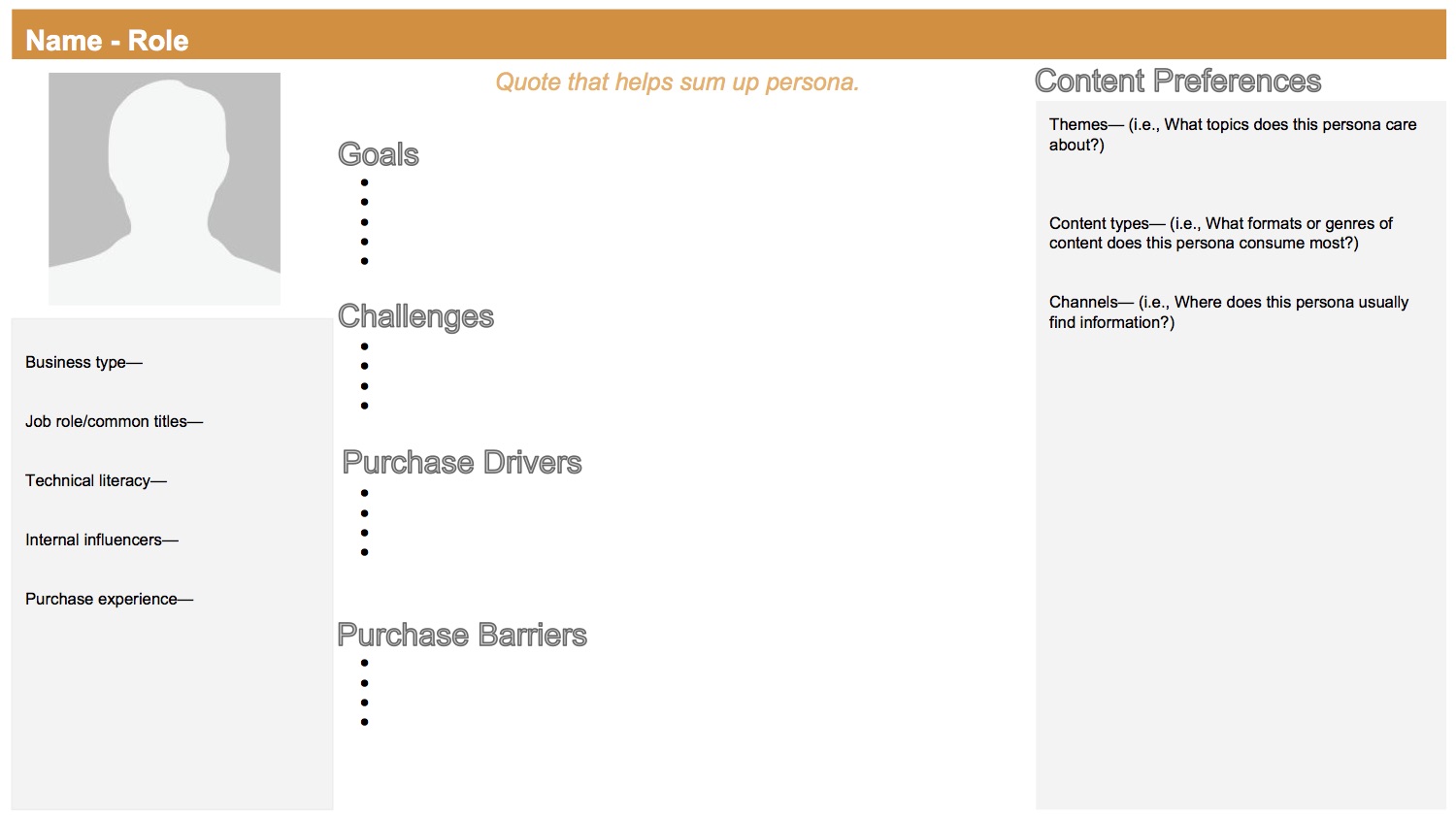From the time of Don Draper in the hit show Mad Men to mega Super Bowl ad spends in the 1980s, marketers traditionally relied on demographics and social trends to target and segment broad audiences. In the 2000s, digital marketing revolutionized marketers’ ability to reach more specific segments.
One risk of data is losing sight of the real people behind the numbers. Without analytics, we know nothing about the prospects behind the clicks. In 1985, a software designer named Alan Cooper invented a user persona named Kathy to add human context to the development process.
Over the years, marketers built on that idea to develop buyer personas – profiles of fictional people that embody several ideal client characteristics. Creating buyer personas is a subjective and analytical process based on data and actual customers or prospects.
The idea is to translate the raw traffic like this:

Into information to help you fill out a buyer persona template, like this:

Source: Hubspot
Why Buyer Personas Work
The buyer persona helps craft tailor-made experiences for every buyer category. In a time when empathy and personalization are more crucial than ever for funnel performance, teams must develop a granular view of the buyer’s points and journey through touchpoints to a sale.
A well-defined buyer persona can improve demand gen by filtering traffic for top-quality leads exhibiting strong buyer intent. While companies should tailor their personas to their industry and other factors, here are some basics all personas should include:
- Demographics: Age, gender, location, income, etc.
- Psychographics: Interests, values, lifestyle, personality traits.
- Goals: What they want to achieve using your product or service. What are their motivations for considering your product or service?
- Challenges: Pain points and obstacles they face in reaching their goals.
- Buying Behavior: Is this a B2B or B2C customer? How do they make purchasing decisions?
- Preferred Channels: Where they gather information and engage online.
Behavioral Analysis and Intent Data for Buyer Personas
Effective buyer personas use quantitative and qualitative data to segment data about existing customers, website visitors, and leads. This data may include information from website analytics tools, interviews, social media insights, and customer interactions.
Customer surveys are also helpful in fine-tuning segments and gauging customer intent. Human nature means people don’t always do what they say they might. Analytics data combined with surveys help marketers see how well what people say correlates with the actual behavior of the website traffic.
Analyze data for visitor browsing behavior patterns, content consumption, engagement levels, and purchasing history. This analysis will help you understand their preferences, pain points, and motivations.
Buyer intent refers to prospects’ actions or expected behaviors before purchasing. Analyze the keywords they use in searches, the content they engage with, and their actions on your website. Are they looking for information, comparing products, or ready to purchase? Intent analysis identifies which actions signal intent to buy as they move through the funnel.
AI-Driven Personalization Engines for Buyer Personas
AI-powered personalization is providing new tools to elevate customer experiences. By harnessing artificial intelligence (AI) and machine learning, enterprises can delve deep into extensive customer datasets about online behaviors, transaction history, social media engagements, and demographic insights.
Implementing AI personalization includes:
- Data collection and integration into customer data platform (CDP).
- Using AI algorithms to segment customers.
- Automating marketing messages and content tailored to each customer persona, such as personalized email campaigns.
AI algorithms enable the personalization of the customer journey in real-time, detecting shifts in customer behavior and updating personas. Dynamic content generation can match snippets of content that resonate with specific personas, offering responsive options and recommendations that adjust for buyer personas.
Keeping up with prospects across channels has long been a challenge for marketers. AI can help synchronize personalization efforts and create more of an omnichannel user experience.
AI is rapidly evolving and still very early. Companies need to watch for bias in AI that could have unintended results. Consumers are more sensitive about their data than in the past. Governments are stepping in with privacy and data protection regulations. Companies that adopt transparency and ethical guidelines around the use of data and AI will maintain customer trust.
Account-Based Marketing Personas
Account-based marketing (ABM) is a B2B model that adapts the persona concept to create personalized experiences for entire target accounts rather than individual prospects.
While regular customer personas offer valuable insights into your customer base as a whole, account-based customer personas are laser-focused on a select few high-priority accounts.
This approach aims to develop hyper-personalized strategies that lead to more effective engagement and conversion within these critical accounts.
ABM marketing typically targets large accounts where a buying group decides over an extended period. Account-based customer personas dive into the specific organizational structure, key decision-makers, pain points, objectives, challenges, and opportunities within the target account.
The goal is to gather in-depth insights that you can use to create personalized and highly relevant strategies. For a deep dive into ABM personalization in action, check out our video, The Secret to Making Your ABM Personalization Campaign a Success.
In crafting ABM buyer personas, sales teams should realize that B2B prospects want a DIY discovery process. More than that, 33% would rather not talk to another human to complete the sale. (source: Gartner Sales).
Increasingly, sales will be won or lost by depending on getting the right content at the right time to the prospect via dynamic content generation and B2C UX. B2B prospects also appreciate experiences that “feel” more B2C, such as virtual tours or shopping cart-like check-out processes.
Moving Ahead
Every innovation disrupts the status quo, but eventually, the entire sector smooths into the next level. The 1990s transition from analog marketing to digital is a great example. Today, AI and other innovations are revolutionizing marketing with more personalization and precise buyer persona targeting.
All of these changes may improve results, but they also increase complexity. If you need help figuring out where to start, we can help. Our FunnelEnvy customer data platform enables you to create a personalized experience that responds to your website visitors within milliseconds. Reach out today to get the conversation started.







